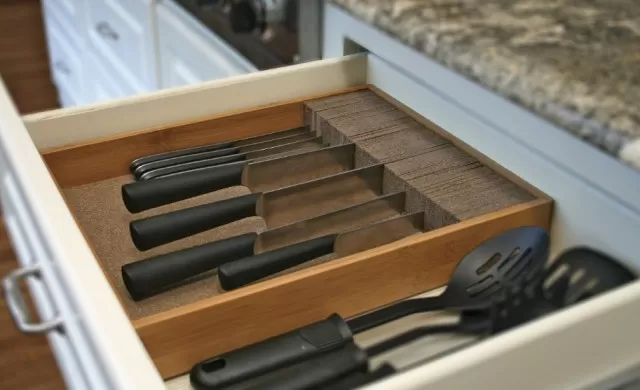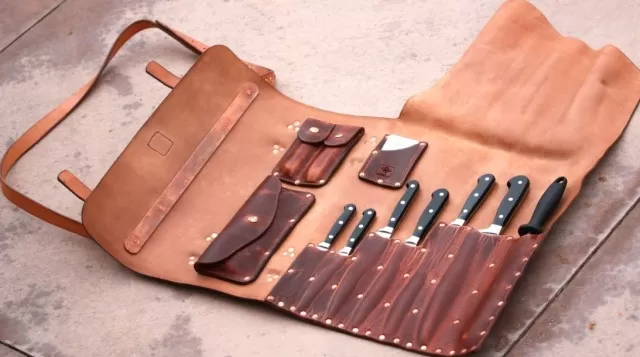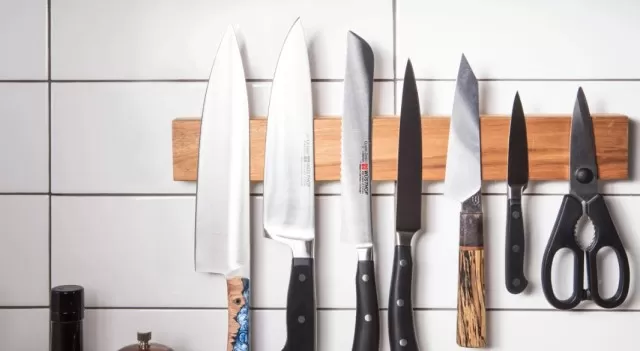It’s crucial to acknowledge their significance and the need for proper handling. This might entail reconsidering storing knives in wooden knife blocks.
Although wooden blocks are a prevalent storage choice, they may not be the most suitable option.
Storing knives in wooden blocks can lead to blade dullness and create an environment conducive to the growth of yeast, mold, and other harmful microorganisms.
A study on household germs conducted by NSF International, an independent testing organization, placed the knife block at the seventh position on the list of the germiest items in the kitchen, trailing just behind the refrigerator’s meat compartment.
Lisa Yakas, a microbiologist and consumer product safety expert at NSF International, elucidates, “Naturally, if you put a wet or soiled knife into a storage block, microbes may proliferate. Dark and humid surroundings are breeding grounds for germs.
The key is to thoroughly wash and dry your knife before storing it. “.
While regularly cleaning your knife block is a viable option, there are alternative knife storage solutions that not only safeguard the blades but also ensure the safety of the individuals using them.
In-Drawer Knife Block

In-drawer knife storage doesn’t entail haphazardly tossing your knives in with other kitchen utensils or squeezing them into a miniature version of a knife block within a drawer.
Instead, this method, favored by professional chefs, necessitates only a drawer and a towel. Chef Ming Tsai, a James Beard Award winner, restaurateur, and founder of MingsBings.
com, shares his approach: “I use a knife roll when I travel for events, but I lay down my knives horizontally in drawers at home. I place them on a towel without allowing them to come into contact with each other to prevent dulling caused by repeatedly inserting and removing them from a traditional knife block.
My smaller knives go in front horizontally, while the longer ones are placed perpendicular to the drawer. “.
Pros of in-drawer knife storage: This option is easy to maintain as it only requires washing the towel and ensuring that the knives are stored dry.
Additionally, it keeps knives off the countertop and out of the reach of children and pets. Importantly, it is the best choice for preserving the integrity of your knives since the blades never come into contact with hard surfaces like wood or metal.
Cons of in-drawer knife storage: Some drawers may not be sufficiently spacious to accommodate a large number of knives, typically exceeding 15 or so.
As a result, you might need to find alternative storage for your steak knives while reserving the drawer for your most essential knives, such as the chef’s knife, paring knife, serrated knife, and others.
Magnetic knife holder Strip:
Magnetic Knife Holder strips provide a practical and space-saving solution for kitchen knife storage.
These strips can be easily affixed to your kitchen wall, freeing up valuable counter space and ensuring a hygienic storage environment for your knives. Setting up these magnetic strips is a straightforward do-it-yourself task, and they are available in both metal and wood variations.
Advantages of magnetic knife storage: This method is a favorite in many restaurants for good reasons.
It allows for easy sanitation of knives since they are stored openly, exposed to air circulation. Additionally, magnetic strips grant quick and convenient access to your knives, making it effortless to grab the right one for your culinary tasks, whether it’s chopping, slicing, or dicing.
Disadvantages of magnetic knife storage: While magnetic knife holders offer several benefits, they may pose certain risks, especially in households with pets or young children.
The display of sharp blades can be enticing and potentially hazardous. Additionally, the strength of the magnets used in these strips could exert undue stress on the blades of your knives over time, affecting their sharpness and longevity.
Leather Knife Roll Storage Bag:

The leather knife roll storage bag, a choice frequently favored by professional chefs for transporting their tools, is gaining popularity for home use as well.
Some high-end knife manufacturers even opt to ship their products to customers in these protective rolls.
Advantages of knife rolls: Leather knife rolls offer a secure storage solution, keeping knives out of reach of children and pets.
Each roll typically features custom slots designed to hold each knife horizontally, protecting the blades from damage. These rolls are durable and portable, making them suitable for travel or picnics.
Beyond their functionality, they also add a touch of elegance to your kitchen setup.
Disadvantages of knife rolls: While leather knife rolls have their merits, they may not be the most convenient option for everyday kitchen use.
Accessing a specific knife requires a few extra steps compared to other storage methods, which may not be ideal when you need a knife quickly during food preparation. Additionally, knife rolls may not accommodate a large collection of knives, so it’s advisable to store your steak knives separately and reserve the leather roll for your larger, more essential knives.
No-Slot Knife Block:
Not all knife blocks follow the conventional slot-based design, and the slotless varieties offer a hassle-free maintenance experience while keeping your knives clean and accessible.
These blocks typically feature plastic or rubber rods that are flexible enough to accommodate most standard-sized kitchen knives.
Advantages of slotless knife blocks: One significant advantage is the ease of cleaning these blocks.
You can simply remove the entire rubber or plastic rod base and place it in the dishwasher for effortless sanitization. Moreover, knives stored in slotless blocks are easily accessible, and many models are quite budget-friendly.
Disadvantages of slotless knife blocks: While slotless knife blocks offer convenience, they do occupy counter space and keep knives within easy reach, which can be a concern if you have inquisitive hands or curious pets around.
Additionally, the rods may not always withstand extremely sharp knives, and they can deteriorate if knives are not inserted correctly.
Magnetic Knife Block:

The magnetic knife block serves as an ideal compromise for home cooks who appreciate the convenience of a knife block but also desire the easy maintenance of a magnetic strip.
These blocks often boast a modern and stylish aesthetic, such as those crafted from American walnut with embedded rare earth magnets for a sleek look.
Advantages of magnetic knife blocks: Knives stored in magnetic blocks enjoy a moisture-free environment with adequate airflow, simplifying the cleaning process.
These blocks are user-friendly, visually appealing on the countertop, and can even double as a decorative piece in your kitchen.
Disadvantages of magnetic knife blocks: While magnetic knife blocks offer many benefits, they do have some drawbacks.
Knives are prominently on display and easily accessible to children and pets, which can pose safety concerns. Moreover, improper handling may potentially dull the blades of your knives, although most models are designed with user-friendliness in mind to mitigate this issue.
*The information is for reference only.